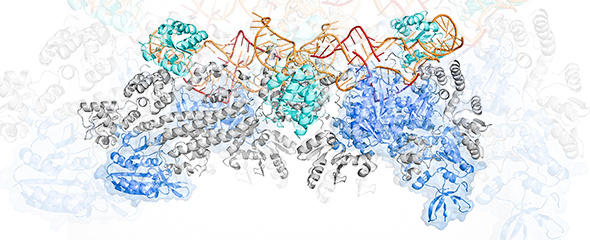Like tiny machines, proteins in our body do hard work. Virtually all processes are performed or controlled by these highly specialised protein molecules. They transmit signals, convert energy, initiate chemical reactions or provide growth and movement. These partially very complex protein machines, such as RNA polymerases, are not easy to decode in their structure and function. Usually, scientists use methods of protein crystallography or electron microscopy for this purpose. However, these methods have the disadvantage that they can impair the natural form and function of the proteins and nucleic acids.
Prof Teresa Carlomagno, head of the research group “NMR-based structural biology” at the HZI, thus follows a different approach: She studies large protein-RNA complexes in solution with nuclear magnetic resonance spectroscopy (NMR). This is a method for examining the electronic environment of individual atoms and the interactions with the neighbouring atoms. “The great advantage of the method is that we can experience complex protein machines as active enzymes at work, with their natural dynamic folding and shape,” says Carlomagno.
The team around Teresa Carlomagno went a step further and has now developed a modern platform that is capable of integrating various experimental data. “The data can, for example, come from mutational analyses, NMR spectroscopy, electron microscopy, fluorescence spectroscopy, or modelling,” explains Carlomagno. “By combining all methods, a calculation of the protein complex is possible, which gives us a first idea about what we are faced with. At the same time, the M3 platform also provides scientists with information when data are not yet sufficient and further experiments are necessary to accurately describe the protein machine.”
Teresa Carlomagno and her team currently have many opportunities to research and to implement the M3 platform in close cooperation with other HZI working groups. Together with the team of Prof Rolf Müller at the Helmholtz Institute for Pharmaceutical Research Saarland in Saarbrücken, the researchers are investigating, for example, so far unknown protein machines that form anti-infective ingredients. These are urgently needed in the development of new antibiotics.
About the “M3 Framework”
The M3 Framework is a broadly applicable and user-friendly platform, which effectively integrates single and very mixed structural and biochemical data of different origins and calculates an atomic structure of complex molecular structures. The protocol of the platform is based on the HADDOCK application, which is publicly accessible. The M3 Framework is an easy-to-understand and intuitive platform. Users need no special computer or programming skills to work with M3. The application is publicly available for download under the link https://github.com/ezgikaraca/ISD-files.
Original publication
Ezgi Karaca, João P. G. L. M. Rodrigues, Andrea Graziadei, Alexandre M. J. J. Bonvin, Teresa Carlomagno: M3: an integrative framework for structure determination of molecular machines. Nature Methods, 2017, DOI: 10.1038/nmeth.4392

